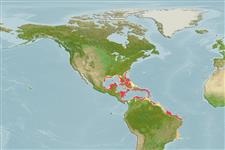Common names from other countries
Environment: milieu / climate zone / depth range / distribution range
Ecologia
; intervalo de profundidade 0 - 88 m (Ref. 83435). Tropical; 34°N - 21°S, 97°W - 29°E
Eastern Central Pacific and Western Atlantic: North America.
Length at first maturity / Tamanho / Peso / Idade
Maturity: Lm ? range ? - ? cm Max length : 3.4 cm NG macho/indeterminado; (Ref. 83435)
This species is found in supra-, sub-, and intertidal coral reefs, reef lagoons, and cienaga facies, particularly on algae, boulder, coral, mud, sand, rock, seagrass and shell habitats (Ref. 83934).
Life cycle and mating behavior
Maturidade | Reprodução | Desova | Ovos | Fecundidade | Larvas
Members of the order Neotaenioglossa are mostly gonochoric and broadcast spawners. Life cycle: Embryos develop into planktonic trocophore larvae and later into juvenile veligers before becoming fully grown adults.
Bright, T.J. 2010. (Ref. 85586)
Status na Lista Vermelha da IUCN (Ref. 130435)
Status no CITES (Ref. 108899)
Not Evaluated
Not Evaluated
Uso pelos humanos
| FishSource |
Ferramentas
Mais informação
Idade/Tamanho
Crescimento
Comprimento-peso
Comprimento-comprimento
Morfologia
Larvas
Abundância
Fontes da internet
Estimates based on models
Preferred temperature
(Ref.
115969): 23.6 - 28, mean 26.7 (based on 306 cells).
Categoria de preço
Unknown.
